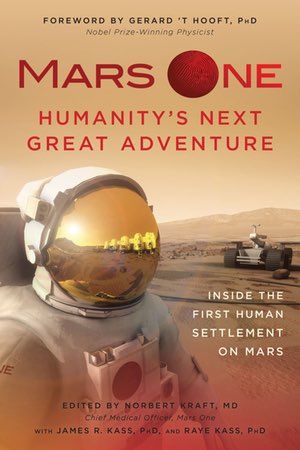Review: Mars One: Humanity’s Next Great Adventureby Jeff Foust
|
| “This assumption cannot be further from the truth,” the editors write about reality TV aspects of Mars One, although the book includes a chapter written by a reality TV show contestant. |
A new book is, perhaps, an effort to keep its name out there, and to demonstrate that the venture and its advisers have been thinking about at least some of the issues associated with one-way Mars missions. Mars One: Humanity’s Next Great Adventure is a collection of essays that examines the thought that they have put into what it means to have a small group of people living and working on Mars, with no plans for return to Earth.
The emphasis of the book is on human factors issues, rather than technology, science, or other topics. Essays examine some of the medical issues associated with long-duration spaceflight, with an even greater emphasis on cultural issues, such as how to get a small group of people—the initial crew will be just four—to effectively work together.
Mars One has tried to downplay the “reality TV” elements of its plan, either for the selection of crews or broadcasts of the missions themselves. “This assumption cannot be further from the truth,” the editors write about those aspects in the introduction of one section of the book. Yet, they do acknowledge that it will “inevitably have some things in common with the traditional reality-show format.” One chapter, written by a woman who, with her husband, won a season of The Amazing Race reality TV show, talks about what it’s like to be on such a show, such the creation of personas for the show that are different from what they’re like in, well, reality.
The book, though, omits discussion of some of the biggest and most controversial issues associated with Mars One. There is, for example, no discussion of the technological issues associated with sending people to Mars, beyond a brief discussion of the habitats they’ll live in. The spacecraft that will get them there, and land them safely, are not discussed. That last point is critical: NASA notes that, today, it doesn’t know how to safely land spacecraft on the surface of Mars much heavier than one metric ton, yet even a basic small human lander is likely to weigh dozens of times as much, not to mention all of the other hardware and supplies needed to live indefinitely on Mars.
Then there’s the question of funding. Mars One, on its website, continues to claim that the cost of getting that first crew on Mars will be only about $6 billion, or a little more than twice the cost of the Curiosity rover mission. That cost has not been publicly and independently verified. Moreover, how Mars One will raise that $6 billion is unclear: they have argued for a model that involves the sale of media rights, at least in part, likening such a mission to the Olympics or World Cup. Yet, at the same time, Mars One is trying to distance itself from the reality TV model that a media rights-driven financial model would likely require.
| “If it is at all possible, humans should be enabled to travel to Mars, though I still think that it will take longer, perhaps much longer, than ten years before a manned spaceship can lift off toward Mars, and that the cost will be more than the estimated 6 billion,” ’t Hooft writes. |
Mars One: Humanity’s Next Great Adventure demonstrates that those advising Mars One have given careful thought to some of the key issues associated with such missions. Yet, those issues are necessary, but alone not sufficient, to ensure its long-term success: knowing how to survive as a small group on a distant, dangerous world is of little use if you have neither the technology nor the financing to get there in the first place.
That skepticism extends to some of Mars One’s own advisors. In the book’s foreword, Dutch physicist and Nobel laureate Gerard ’t Hooft, who serves as an “ambassador” for Mars One, says while he’s taken by Mars One’s vision and ambition, he is still skeptical about its cost and schedule. “If it is at all possible, humans should be enabled to travel to Mars, though I still think that it will take longer, perhaps much longer, than ten years before a manned spaceship can lift off toward Mars, and that the cost will be more than the estimated 6 billion,” he writes. Mars One may not succeed, he concludes, “but whatever errors it makes now will be extremely instructive for the next initiatives.” Those future initiatives, at the very least, can learn about some of the human factors issues from this book. For the technological and financial issues, though, they may need to look elsewhere.
